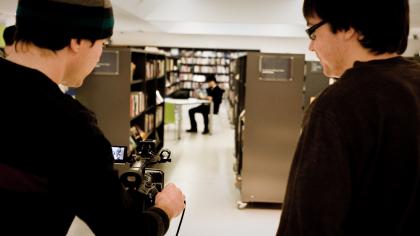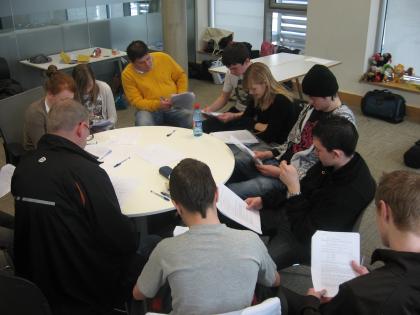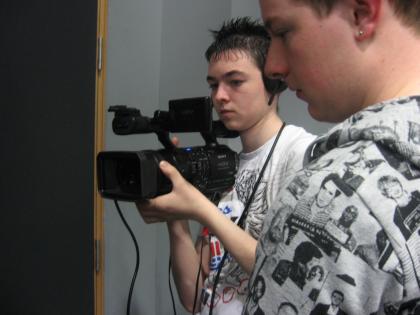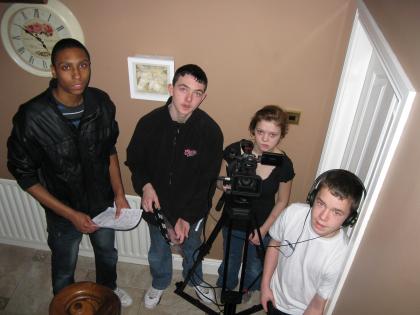By Victoria Durrer - Youth Arts Co-ordinator, South Dublin County Council
This paper unpicks what is meant by the term ‘youth-led’ within youth arts work. It seeks to clarify, from the perspective of work carried out with the Tallaght Young Filmmakers and South Dublin County Council’s Arts Office, that the term is a way of working with young people that is dependent upon the situational context in which a project or programme may rest. In addition, the risks and limitations associated with such an approach are explored. Through this discussion, it is hoped that a greater understanding of the terms and conditions for taking a youth-led approach within youth arts programmes are reached.
Introduction: A Policy Context
The work carried out under the terminology of "youth arts" can often be variously defined. Within a national policy context in Ireland, the sector is largely understood as "the practice of all art forms in sectors that are not part of the formal education system, in which young people in the 12-25 year age range engage as active participants [in] or as consumers/audience members [of the arts] in their own free time" (Coughlan 2002: 5). "Youth arts" may also include the engagement of (adult) artists and arts practitioners as well as youth workers who facilitate arts activities, workshops, and collaborative work, with and for young people. Additionally and more recently, however, "youth arts" is understood as including consideration of young people not only as "recipients" of arts activities and events but also as artistic "contributors" or creators themselves (Arts Council 2005a: 1).
As part of a local authority responsible for addressing national governmental policies (House of the Oireachtas 2003), the Arts Office of South Dublin County Council plays a critical role in promoting, fostering, and supporting the development of youth arts within its locality. As research commissioned by the Arts Council indicates, local authorities have the opportunity to improve local advocacy, build networks, increase the availability of opportunities for young people to participate in the arts, promote youth ownership over their arts experiences, and serve as intermediaries for their local youth arts sector within a national policy perspective (Coughlan 2002; Bartlett 2006).
Within Ireland, there has been a shift at governmental levels, both nationally and locally, in addressing the needs of young people. This change "includes an increased professionalisation of services for young people, an expansion of the remit of a number of government departments in relation to young people and an acknowledgement of the need to build-up a substantial body of knowledge in this area" (Arts Council 2005a: 1).
Since at least 1995, within the arts and cultural sector more specifically, this shift has included a call for acknowledgement of young people’s engagement in the arts as an area of work in its own right (Arts Council 2005b). In fact, those working within the youth arts sector have been advocating for more strategic support on a national level of young people’s access to, and participation in, the arts (Coughlan 2002; Arts Council Ireland 2005b). Matters of particular concern have focused on gaining a better understanding of existing youth arts practices and mechanisms to support and enhance practice, as well as setting guidelines and advocating for "best practice." Additional considerations have included examining better ways to provide opportunities for networking and knowledge-sharing within the sector and to increase the "capacity and opportunity" for youth voice in artistic and cultural matters (Arts Council Ireland 2005a: 2).
Taking youth voice into the account of provision of youth arts has become more significant within national agendas. In March 2010, the Arts Council brought together sixty young people between the ages of fifteen and twenty-three for an event entitled Art-Youth-Culture: FYI. The aim was to provide an opportunity for young people to discuss their participation in cultural life and the arts with their peers and key policy makers. More recently, the National Youth Council of Ireland’s Arts Programme has begun an initiative entitled Youth Arts Works. In alliance with young people and youth arts practitioners affiliated with several arts organisations and national cultural and youth bodies, the scheme aims to encourage maintenance of funding, advocacy and support for youth arts in light of national budget cuts by highlighting that access to the arts for young people is a right, not a privilege. The initiative is not only a reflection of the UN’s Convention on the Rights of the Child (UN 1989), but also of research conducted directly with young people and the public in Ireland (Drury 2006; NYCI 2008).
Working within this context, South Dublin County Council’s Arts Office continues to learn and develop its practice toward delivering its remit to foster and encourage the high quality artistic development of young people within its geographic area. In doing so, the Arts Office strives to take an approach that promotes young people’s ownership over their artistic and creative potential, development and future. Such an approach is defined by the Arts Office as striving to be youth-led. The discussion presented here admits a continued (and necessarily so) reflection within the Office on what is meant by the term ‘youth-led’. It also considers the rationale for such an approach as well as what conditions are necessary to foster youth-led work within the arts in South Dublin County.
The Terms
The term youth-led is more often discussed within academic research with regards to the areas of youth and community development, rather than within an arts or youth arts context. Research by Saito (2006: 68) on youth-led strategies for youth programme development and youth engagement has shown that programming of activities for pre- and early age teenagers must "recognises this age group’s unique developmental need to have increasing levels of autonomy and authority in the design and implementation of their program or project."
As a result, Saito (2006: 68) argues, judgments on the quality of youth programming, in general, are often based on the following criteria:
• Safe places to be with peers and take part in enjoyable, ‘cool’ activities
• Programmes/activities where young people may be involved in leadership roles and decision making
• Opportunities to have "new experiences, and develop caring, respectful relationships with other young people and adults"
• Environments and circumstances where young people’s opinions "matter"
• Environments and circumstances in which young people may be involved in affecting "real change"
• Young people have a stake in programme success
Saito’s (2006: 69) research also shows that many young people acknowledge poor quality projects as:
• Programmes that are disorganised, chaotic and lack accomplishment
• Programmes that have too may participants
• Programmes that have a lack of attendance
• Programmes in which young people are not given any responsibility nor authority
• Programmes in which young people feel "underestimated" and are "talked at" by group leaders too much
These criteria are felt to be relevant in defining quality and best practice approaches within a youth arts context. In fact, the lived reality of the involvement of young people in the shaping and delivery of youth arts projects and longer-term programmes is inextricably linked to the perception and reality of ‘quality’ adults and young people within the sector feel programmes do have.
In general, young people are often seen to have input into the direction and daily running of youth arts projects and longer-term programmes. However, the ways in which project and programme structures are established and enacted in order to encourage, foster, and allow for young people’s input, authority and daily decision-making may vary. This variation consists of differing levels of what may be termed ‘adult-led’ versus ‘youth-led’ delivery mechanisms (Larson, Walker, and Pearce, 2005).
As explained by Larson, Walker and Pearce (2005), adult-led programmes consist of adults employing greater control over daily programme activities, but with the input of young people included. They also explain that youth-led programmes involve young people having greater control of activity development, but with adults serving "supportive roles as mentors and facilitators" (Larson, Walker, and Pearce 2005: 58). In fact, research demonstrates that young people often enjoy working "experientially in project-based models in which they have some level of autonomy and influence over important decisions" (Saito’s 2006: 72).
Adult-Led Programmes:
Within the ‘adult-led’ approach is a belief that adults may have greater understanding for and experience in guiding programme activities. The main objectives of such a method are often the teaching of "specialised skills...that youth desire to learn" (Larson, Walker, and Pearce 2005: 58). Research often terms this approach in relation to student-centred teaching that stresses "adult leadership that is sensitive and responsive to young people" (Chall 2000; Larson, Walker and Pearce 2005: 59). Typically, adults set a framework of rules, structures and roles that provides an opportunity in which young people may give input (Opelt 1991; Roberts and Treasure 1992; Larson, Walker and Pearce 2005).
While such an approach allows for the input of young people in decision-making processes, there are limitations. The ownership and creativity of as well as learning by young people within projects may be limited because adults may be seen as an authority to be adhered (Freire 1970; Vygotsky 1978; Larson, Pearce and Walker 2005; Sabo-Flores 2008). Projects that follow such a model may experience a lack of attendance and involvement of young people in programme steering committees as a result (Larson, Pearce and Walker 2005).
Youth-Led Programmes:
Within a ‘youth-led’ approach, the goal is often to promote the empowerment of young people to become leaders. In such programmes, young people may have more opportunity to make and enact decisions. Such approaches are often taken in the context of youth and community development work (Sullivan 2000; Ginwright and James 2002; Larson, Pearce and Walker 2005: 59). In analysing theories on such a youth-led approach, Larson, Walker and Pearce (2005) stress the importance of partnership between adults and youth. While young people may be provided with more leadership opportunities to direct programmes within certain institutional or organisational settings, adults are ultimately responsible for "safety and legal liability" (Larson, Walker, and Pearce 2005: 59). They also explain that much of the limitations involved with such an approach appear to centre on adult concerns and assumptions that young people may not have enough experience to organise and maintain programmes. In addition, misunderstanding around roles of adults versus roles of young people may be encountered (Larson, Walker and Pearce 2005). However, relationships between youth and adults in sharing decision-making powers often build over time and in stages (Jarrett, Sullivan and Watkins 2005).
The Conditions
A common way to articulate young people’s involvement or participation in decision-making structures that affect their lives is via Hart’s ladder of participatory forms (Hart 1992, 1997). Hart critiqued the ways in which governments consult and work with young people regarding issues that affect their lives. He provided an eight-point scale, a ladder, which details ways in which programmes for youth are often structured. Towards the bottom rungs are descriptions of typologies that ‘manipulate’ youth or involve them in a tokenistic way. Towards the top rungs of the ladder is what he refers to as genuine participation, where young people have specific roles from adult-initiated to eventually youth-initiated discussion and decision-making (Hart 1992, 1997).
More recent discussions on the participation of young people in decision-making, particularly in relation to public services for young people, have begun to reassess Hart’s initial appraisal. These researchers, Head (2010) explains, find Hart’s critique to be prescriptive and inflexible, lacking consideration of particular situations and contexts (Chawla 2001; Francis and Lorenzo 2002; Ewen 1994; Sinclair 2004). Rather, Head (2010: 542) calls for "a more nuanced situational approach" that takes young people’s informal participation into consideration in addition to the structures of power (project management) involved in attempting to engage youth. More specifically, such a consideration assists "in the understanding both of current patterns and future possibilities" for such work by examining five types of participatory relationships: informing, consulting, involving, collaborating and empowering (Head 2010: 543).
Both of the ‘adult-led’ and ‘youth-led’ approaches described above are dependent upon youth participation, and the levels at which this participation may be possible are, in turn, dependent upon the context of the institutional and every-day settings in which a project or programme may rest. The organisational or institutional settings and structures, the condition of the physical spaces in which workshops and activities take place, the materials and funding available, the artistic media in which a group is working and developing practice, the learning and developmental needs of young people involved, and the skills of practitioners, facilitators and artists are some of the factors that determine the approaches that may be possible. Within the differing contexts of youth arts work there are different limits and/or risks associated with each approach and as such different strategies are taken to encourage youth participation in the shaping of project development and delivery (Larson, Walker, Pearce 2005). There is no prescriptive ‘right way’ in which to strive for youth leadership in youth arts programmes. No one programme or project is the same.
Tallaght Young Filmmakers-a youth-led approach in reality

One programme in which South Dublin County Council has been involved since 2008 is the Tallaght Young Filmmakers (TYF). The Tallaght Young Filmmakers are described as a youth-led filmmaking group for ages 14 to 19 that meets weekly, with some intensive project periods for specific film shoots during school breaks. Work carried out with this group has provided South Dublin County Council’s Arts Office with a substantial learning curve regarding what it really means to take a youth-led approach. Further, work with TYF has allowed the Arts Office to understand that youth-led work is a balancing act; one that sways, at times, back and forth between the leadership of young people and the encouragement of adult workers.
TYF developed from the initiation of students who had worked with South Dublin County Council’s Film and Visual Arts Coordinator in the local area of West Tallaght. During the 2007 - 2008 school year, students in two different schools had worked on different filmmaking projects that saw them scripting, acting in and directing their own film projects with the support of a filmmaker.
These students came together on a trip to attend master classes offered by Cinemagic Film Festival. During their day-trip together, the students proposed starting an after-school filmmaking group to continue filmmaking beyond the school-based projects that were soon coming to a close. As a result, South Dublin County Council’s Arts Office continued to meet with these young people to collectively establish the aims and objectives of TYF and apply for seed funding from the Arts Council’s Young Ensembles Scheme, newly established in 2008.

The agreed aim of TYF has been to strengthen the infrastructure and excellence of youth film produced in Tallaght through a programme led by and through the voice and creative agenda of the young people involved. In taking a youth-led approach, it was felt that TYF would provide a supportive environment in which young people could gain confidence, experience, and skills in the process of collaborative filmmaking with the assistance of professional filmmakers. Tallaght Young Filmmakers officially formed as a group in September 2008 after receiving funds from the Arts Council’s Young Ensembles Scheme.
At the heart of the youth-led approach taken within the Tallaght Young Filmmakers is an understanding of partnership. In particular, young people, facilitators and local authority Arts Office all have an understanding of what each contributes to the programme as well as the importance of their shared efforts for the group’s sustainability.

The group is facilitated by a Youth Film Leader and supported by a Welfare Officer as well as South Dublin County Council’s Youth Arts Coordinator. Adult workers are there to provide technical and administrative support as well as guide young people on budgets and provide information and advice on project planning and implementation. They also provide support if difficulties or conflicts arise within the group (Greenhat 2006). The Youth Film Leader meets weekly with the group to discuss film projects that may be carried out and areas of learning needed to develop such work. The Welfare Officer supports young people’s participation in the programme as well as contributes to some of the planning of sessional activities. Professional filmmakers are hired through an interview process with the young people themselves to mentor, or advise, the group on how they might carry out particular film projects. In addition, professional filmmakers may become involved to deliver one-off master classes in particular areas of filmmaking. South Dublin County Council’s Arts Office provides funding, the loan of film equipment (through a grant from RAPID, Pobal and Dormant Accounts Fund) and strategic support for the group as well as monitoring and evaluation of the programme. In 2009 after the opening of the County’s new arts centre, RUA RED, South Dublin Arts Centre offered TYF support for meeting space, moving TYF from their original home in Tallaght Library.
Today, the seven member group is now eighteen strong with a waiting list. One member from the original TYF is still involved. The programme has seen three young people go on to study filmmaking at third level and a number of other members go on to facilitate filmmaking sessions for other young people, act in feature films and assist on film shoots. The group has screened their work to a wide audience and won awards in youth film festivals.
The development of youth-led practice within TYF has been a process, not without its highlights and growing pains. Much of the description of the limitations of both adult- and youth-led approaches mentioned above were lived experiences for TYF. At times, adults involved in working with the group held back ownership from young people, for fear that they may not be able to lead and deliver projects to completion. In addition, young people sometimes needed more direction and were not always clear on how to lead the development of specific film projects. In addition, the structures in place, such as frequency of meetings and the processes for feedback and consultation with TYF members were not always effective. Through a process developed over nearly three years, adults and young people involved in TYF have found ways in which to facilitate youth leadership and ownership of the filmmaking programme. These are:
• Being sensitive to the needs of the young people with whom we work as well as the institutional settings in which that work is housed.
• Providing opportunities for young people to meet and work with a variety of professionals/practitioners in workshop and film settings, yet maintaining consistency of support via Coordinator and Welfare Officer roles within the group.
• Taking time and being flexible, allowing mistakes to be made and learned from, by young people and adults.
• Being strategic about where to begin. As mentioned above, it is felt important to acknowledge what one’s starting point is: where the programme is physically housed and what resources, financial, human and material, a programme has are all factors that may affect the extent to which youth-led goals may be delivered upon.
• Balancing letting go: Allow mistakes to be made, but avoid losing the group’s motivation and/or ownership. It is important not to over-stretch oneself to ‘fill the gaps’ adults may feel that young people have left in seeing through a performance, a film or an exhibition out of lack of experience. Allowing young people to realise the gaps and mistakes, while difficult, promotes a level of learning needed for taking leadership. At the same time, adult workers are often required to balance those gaps with advice and guidance so that young people do not feel wholly let down.
• Asking questions. Project planning and programme development within TYF often involves adults questioning young people about project ideas and plans and vice versa. For example, if at all concerned that young people have missed a step in a key aspect of project delivery, often asking questions about what may have been missed can raise awareness. This approach is also very useful for monitoring and evaluating project delivery and individual and group learning on a project. In addition, encourage and support young people to do the same of adult workers involved in projects. Such approaches allow adult workers to better understand what young people (artists) are passionate about as well as what their learning needs are.
• Encouraging learning from mistakes to be immediately applied. Get going on the next project or series of workshops with these areas of learning in mind. This may allow a group to take leadership on how to move forward and gain greater enthusiasm for the next project while highlighting what they’ve gained from the last one.
• Realising that knowledge is cumulative. At the outset of the programme, TYF was described as youth-led. However, while individual film projects may have reflected the ideas of young people at their heart, the programme itself was not fully youth-led, nor could it have been at the time. It has been through the involvement in different film projects, working with different filmmakers, and the joining of new young members with different areas of interest in film that has helped to shape the development of TYF in new directions that has allowed for greater leadership of young people.

Being involved in TYF has assisted South Dublin County Council’s Arts Office in gaining a greater understanding of how to promote youth leadership within youth arts projects. A balance is needed. Youth-led approaches do not mean that young people take complete control over every aspect of programme or even project delivery; however it is driven by them. At times, young people need to know that adult facilitators and artists are there to help and guide. Stepping in to ask a necessary question or encourage a group to meet a deadline, or even assist with that process, is not taking power away from the group, but allowing them to know you are there.
The development of youth-led initiatives takes serious commitment from both the young people and adults involved. These initiatives require flexibility in approaches as well as time, providing environments in which young people are encouraged to learn, take the lead, and then permitted to make mistakes (Greenhat 2006). At the same time, however, it is important for young people to understand that adults, too, need the flexibility and encouragement to make mistakes and learn from them. TYF has been a great opportunity in which both young people and adults have had the time to do just that, resulting in positive learning and creative experiences for all involved.
Works Cited
Arts Council Ireland. (2005a) Young people, children and the arts: Summary policy paper. Dublin: The Arts Council. http://www.artscouncil.ie/Publications/YoungPeopleChildrenandtheArts 280706.
pdf.
Arts Council Ireland. (2005b) Arts council consultation process: Meeting on youth arts. Dublin: The Arts Council.
http://www.artscouncil.ie/Publications/youtharts 130505.pdf.
Bartlett, R. (2006) Development and implementation of youth arts policy in South Dublin County. Dublin: South Dublin County Council. http://arts.southdublin.ie/images/stories/YouthArtsPolicyEnglish V2.pdf.
Chall, J. (2000) The academic achievement challenge: What really works in the classroom? New York: Guilford Press.
Chawla, L. (2001) "Evaluating children’s participation: seeking areas of consensus," Participatory Learning and Action [PLA Notes], 42, pp. 1 - 5.
Coughlan, M. (2002) The participation of young people in the arts in Ireland: A proposed policy and action plan for the period of the Third Arts Plan. Dublin: The Arts Council.
http://www.artscouncil.ie/Publications/youth arts report.pdf.
Drury, M., with Hibernian Consulting and Insight Statistical Consulting. (2006) The public and thearts 2006 executive summary. Dublin: The Arts Council. http://www.artscouncil.ie/Publications/
PublicandtheArts ExecutiveSummary English. pdf.
Ewen, J. (1994) "Youth participation and social inclusion: a new policy agenda?" Social Policy Issue Brief No 1: University of Sydney.
Francis, M. and Lorenso, R. (2002) "Seven realms of children’s participation," Journal of Environmental Psychology. 22 (1 - 2), pp. 157 - 169.
Freire, P. (1970) Pedagogy of the oppressed. M.B. Ramos, Trans. New York: Continuum.
Ginwright , S., & James, T. (2002) "From assets to agents of change," New Directions for Youth Development, 96, pp. 27 - 46.
Greenhat. (2006) Listen up! Research, consultation and feasibility study into youth-led arts programming, a report written on behalf of Young at Art. Belfast: Young at Art. www.youngatart.co.uk/dloads/listenupreport.doc.
Hart, R. (1992) Children’s participation: from tokenism to citizenship. Florence: UNICEF Innocenti Centre.
Hart, R. (1997) Children’s participation. New York: UNICEF.
Head, B. (2010) "Why not ask them? Mapping and promoting youth participation," Children and Youth Services Review. 33: pp/ 541 - 547.
House of the Oireachtas. (2003) Arts Act 2003. Dublin: House of the Oireachtas. http://www.irishstatutebook.ie/2003/en/act/pub/0024/index.html
Jarrett, R., Sullivan, P. Watkins, N. (2005) "Developing Social Capital through Participation in Organised Youth Programmes: Qualitative Insights from three Programmes," Journal of Community Psychology. 33:1, pp. 41-55.
Larson, R. Walker, K. and Pearce, N. (2005) "A Comparison of Youth-Driven and Adult-Driven Youth Programs: Balancing Inputs from Youth and Adults," Journal of Community Psychology, 33:1, pp. 57 - 74.
NYCI. (2008) Young people, creative action and social change-a report on the value of the arts for young people. Dublin: National Youth Council of Ireland.
Opelt , J.R. (1991) Organising and managing the high school theatre program. Boston: Allyn and Bacon.
Roberts, G.C., and Treasure, D. (1992) "Children in sport," Sport Science Review, 1:2, pp. 46 - 64.
Sabo-Flores, K. (2008) Youth Participatory Evaluation: Strategies for Engaging Young People. San Francisco, CA: John Wiley and Sons, Inc.
Saito, R. (2006) "Beyond access and supply: Youth-led strategies to captivate young people’s interest in and demand for youth programs and opportunities," New Directions for Youth Development. 112, 57 - 74.
Sinclair, R. (2004) "Participation in practice; making it meaningful, effective and sustainable," Children and Society. 18 (2), pp. 106 - 118.
Sullivan, L. (2000) "An emerging model for working with youth: Communit y organizing youth youth organizing," Funders Collaborative on Youth Organizing.
UN General Assembly. (1989) Convention on the rights of the child, 20 November 1989, United Nations, Treaty Series, vol. 1577:3. http://www.unhcr.org/refworld/docid/3ae6b38f0.html.
Vygotsky, L. (1978) Mind in Society. Cambridge, MA: Harvard University Press.


No comments added